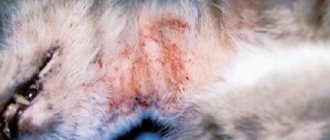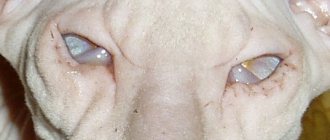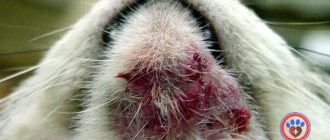13.06.2019
Skin diseases in cats
no comments
5395
Ever since cats became the most popular pets, there seems to be a constant rise in dermatological diseases. One of the common skin diseases, the treatment of which we will look at in this article, is atopic dermatitis .
Statistics show that most individuals with atopy are orange or partly orange (that is, tri-colored or tortoiseshell). Of course, there are different colors, but most atopic cats are orange in color.
Purebred and purebred pets are also more prone to atopy. Allergic atopic dermatitis in cats does not have classic signs, unlike dogs. Therefore, it is necessary to exclude several differential diagnoses before making a diagnosis.
Dermatitis in cats: general information
Many owners do not know about this, but dermatitis, in essence, is not one disease, but represents a whole group of different skin ailments. Their common feature is the point of localization of manifestations, that is, the skin.
The irritated areas can be widespread or localized, but in all cases the dermatitis will spread throughout the body over time.
According to the current classification, three main types of dermatitis can be distinguished based on the nature of clinical manifestations. We will consider which ones in the table below.
Table 1. Types of dermatitis according to the nature of symptoms
| Superficial dermatitis | Purulent dermatitis | Wet dermatitis |
The mildest form, since it is its symptoms that bother the animal the least. With superficial dermatitis, the following clinical manifestations are observed:
| During its development, the animal's body is covered with very itchy small ulcers, which the animal constantly scratches, bites, and licks. Inflammatory processes in this case are extremely active, very often against the background of bacteria of the pathogenic category being introduced onto the affected skin, secondary infectious processes are added | Weeping dermatitis is perhaps the most unpleasant form of the disease we are considering. The skin affected by wet dermatitis softens and becomes as if torn off in some places. At the same time, the following oozes from the affected areas:
|
Dermatitis can form anywhere on a cat's body.
Please note: many unscrupulous owners do not come to the aid of their pets until the last minute, and even drive them out into the street when they discover dermatitis, all because they think that a cat’s disease can be transmitted to humans. We can only condemn these ignoramuses and sympathize with their poor pets. All speculation that a person and a cat can infect each other with dermatitis is just a myth.
Feline dermatitis is not transmitted to humans
It must be said that the clinical manifestations of the disease in any form and advanced stage look frightening in appearance. Sooner or later the body of a cat becomes covered with:
- a large number of blisters;
- ulcers;
- eczema.
However, in most cases, dermatitis is simply a symptom of problems in the body, that is, a secondary disease, while the root cause may not be clear for a long time.
Dermatitis is a secondary disease
Symptoms of dermatitis
So, the symptoms of the desired disease, regardless of the reasons that caused it, will be as follows:
- the presence of a rash on the skin of the animal;
- constant scratching of the same affected areas with the teeth and paws of the animal;
- local redness;
- inflammatory lesions on the skin;
- swelling of the affected areas;
- blisters and blisters on the skin;
- ulcers;
- cracks;
- skin is very dry;
- due to dryness, skin scales form;
- hair loss;
- when you touch the affected areas, the skin feels very hot;
- The cat constantly feels that his skin is not only itching, but also as if it is burning.
With weeping dermatitis, moist, inflamed areas on the skin are observed.
Exactly how the same type of dermatitis will look on two different animals will depend on each pet's individual tolerance. So, at the same stage of development of the disease, one animal will scratch itself, thereby indicating redness to the owner, while the other will lose all its fur and bite itself until it bleeds.
Diagnostic methods
It is difficult to identify the disease, so most often cats are diagnosed with flea or food dermatitis. Because of this, treatment may not be effective. Only an experienced veterinary dermatologist can diagnose atopic dermatitis based on tests, observation of the animal and exclusion of similar pathologies.
First you need to rule out the presence of parasites, scabies, demodicosis or lichen. Blood tests and skin scrapings will help with this. The presence of food allergies is more difficult to identify; to do this, you need to feed your pet only hypoallergenic food for at least 2 months. If the symptoms of dermatitis have disappeared, then it is foodborne.
It is impossible to confirm the presence of atopic dermatitis by external signs alone. For an accurate diagnosis, you need to do an intradermal test for allergens. It is carried out after excluding flea or food dermatitis, parasitic diseases. Allergens are selected individually, depending on the living conditions of the animal. Typically these are dust mites, mold, plant pollen, and bird feathers.
But an allergy test is an expensive procedure. Therefore, cats are diagnosed based on symptoms and observation of the animal. For example, the presence of this disease is indicated by its exacerbation during the flowering period of plants. Symptoms may disappear when you change your diet, change your place of residence, or after giving up certain cosmetics.
Forms of dermatitis in cats and stages of its development
We can distinguish three forms of the disease we are interested in:
- subacute;
- spicy;
- chronic.
There are three forms of dermatitis in cats: acute, subacute and chronic.
Provided that the pet receives improper treatment, dermatitis from an acute form can develop into a chronic form, which implies the following:
- the course of the disease will weaken;
- symptoms will subside as much as possible or even go away;
- periodic exacerbations of the disease will occur.
It is almost impossible to completely cope with this form of the disease. That is why, at the first symptoms of a disease, for example on your pet’s ears, you should immediately seek treatment from a veterinarian.
Types of dermatitis: reasons for their development
There are two types of dermatitis. Let's look at them in the table below.
There are two groups into which all known types of dermatitis can be divided: simple and allergic
Table 2. Types of dermatitis
| Simple | Allergic |
Simple dermatitis refers to the reaction of the skin of an animal that has come into direct contact with some irritant, for example:
| The second category of dermatitis includes those skin lesions that arise as a result of an allergy - a reaction of the cat’s immune system to any substance that has entered the body and is recognized by it as hostile and dangerous. Unfortunately, an allergic reaction can develop to absolutely any irritant, which in the literal sense is not even such, for example, to:
|
So, based on the information indicated in the table, we can draw conclusions about the causes of dermatitis in cats today.
Ectoparasites and endoparasites
Ectoparasites are very small harmful insects that settle on the body of cats and feed on it:
- epithelial cells;
- blood;
- plasma, etc.
Ectoparasites often torment not only cats, but also dogs, as well as other domestic animals and livestock.
We are talking about well-known “enemies”:
- fleas;
- ixodid ticks;
- demodex mites;
- lice eaters;
- lice, etc.
How to recognize a lice eater?
The paws of parasites that land on your cat’s skin are contaminated with a huge number of bacteria, which in turn provoke the development of simple dermatitis, actively penetrating through damage in the pet’s skin caused by their carriers.
These same small insects constantly:
- particles of flesh fall off;
- hairs fall off;
- saliva is released when biting the skin of pets;
- feces and other waste products are released;
- Oviposition occurs directly into the pet's skin.
All of the above secretions, if they can be called that, represent flora foreign to the skin of our pets, which also contains foreign protein.
Fleas not only transfer bacterial microorganisms to the animal’s skin, but also damage the epithelium, making it easier for bacteria to penetrate inside.
Since the immune system in cats is really developed, when these “enemy objects” are detected, it begins to actively fight them, turning into irritations on the skin, such as:
- rash;
- irritation;
- ulcers;
- blisters, etc.
Fleas
So, with the so-called flea dermatitis, the manifestations will be as follows:
- constant and very severe itching, localized at the point where the animal’s tail attaches to the body;
- behind the cat’s ears, just where it is most convenient for fleas to bite through the animal’s skin;
- a huge number of reddened spots on the skin;
- formation of “wet” areas and crusts on them;
- constant scratching with paws and teeth.
Life cycle of fleas
The warmer the temperature outside, the more this dermatitis will bother cats, but it can also manifest itself in cold weather, provided that fleas live in your entrance or, for example, basement.
Ixodid ticks
If dermatitis is caused by mites, then the clinical picture will depend directly on the type of parasite that bit the skin. So, provided that the cat was bitten by an ixodid tick, the following will form at the site where contact with the skin occurred:
- severe swelling;
- inflammation;
- itchy area;
- bald;
- rash (not necessary, but may appear).
The ixodid tick can not only cause dermatitis in the animal, but also infect it with a dangerous disease - piroplasmosis
Subcutaneous mites
As for subcutaneous mites, allergic reactions to their presence will spread to the entire body of the animal and manifest themselves in the form of:
- extensive rashes;
- constant, frantic biting and scratching of affected areas;
- Blisters may appear throughout the body, which can then become inflamed further.
Otodectosis (infestation of a cat's ears by subcutaneous mites) can also cause the development of dermatitis, which will manifest itself as:
- ulcers;
- rash;
- redness.
Otodectosis of the ears
Parasites living directly in the skin are perceived by the body as an enemy agent that has penetrated inside the protected system. These foreign elements, unfortunately, are dangerous in that reactions to them can manifest themselves:
- how to activate, colonize and develop in the skin;
- and at the stage of disease progression.
Subcutaneous mites cause not only otodecosis, but also demodicosis. Read about its symptoms and treatment in a special article on our website.
Helminths
Helminthic infestations are another reason for the development of allergies in cats. Once inside the animal’s body, the worms settle inside some organ (most often the intestines), and begin to parasitize there, doing the following:
- releasing toxic waste products;
- eating all the beneficial substances intended for the cat’s body;
- dying, and producing toxic compounds during decomposition.
This is what helminth worms look like
In the above cases concerning ecto- and endoparasites, effective treatment for dermatitis takes place only if the animal has previously been completely rid of the harmful insects inhabiting it. Unfortunately, having cured the disease without removing them, you will wait for its immediate return, since one bite is usually enough for the process to start with renewed vigor.
That is why, in order to prevent the development of dermatitis due to the presence of parasites in your animal, it is better to use preventive protective agents, namely:
- anthelmintic drugs , which are given to the animal once every three months;
- products against fleas, ticks, lice and other insects that parasitize the pet’s skin, which are used when the animal reaches a certain age, at the onset of summer, when they become more active.
Means for helminths are sold in every veterinary pharmacy and are freely sold to everyone.
The form of release of the drugs we describe for worms can be:
- suspension;
- paste;
- tablet.
From fleas, ticks and other parasites that cause harm in a similar way, the following are implemented:
- drops;
- collars;
- pills;
- sprays, etc.
Fungi and bacteria
As we mentioned above, cats are creatures with a hypersensitive immune system that can react to an irritant due to its own excessive sensitivity.
Fungal dermatitis can only be cured with antifungal drugs; antibiotics have no effect in this case
In this case, there is a 100% probability that a reaction will occur specifically to a fungus or any bacteria, even if it is not classified as a pathogenic microorganism.
Signs in this case will manifest themselves individually. So, a cat may suffer from:
- slight skin irritation and redness;
- or from scratched, irritated areas.
Your pet may suffer from minor skin irritations
Very often, dermatitis caused by the irritants we are considering in this section occurs indirectly, in the form of a chronic illness. In this case, the symptoms are often:
- lubricated;
- seemingly without foundation;
- constantly escalating for no reason at all.
Veterinarians often diagnose felines with the following diagnosis: “Malassezia dermatitis.” This disease is caused by a fungus from the category of opportunistic pathogens, which has a yeast nature. This type of fungus can live on the skin of cats for a long time, without causing any harm to them, but being a causative agent of an immune reaction.
Fungal dermatitis, like bacterial ones, is characterized by a course no less acute than, for example, allergic dermatitis
Provided that a favorable environment for the growth of the fungus is created (humidity and high air temperature), the reaction can become much more pronounced. This type of fungus prefers to settle in skin folds, so their favorite location is in the nose area of cats, especially those that have a flat face, for example, standard Persian cats, extreme Persian cats, etc.
Extreme sports enthusiasts are susceptible to fungal dermatitis
In addition, fungi are very often colonized:
- on the chin;
- in the groin area;
- in the area between the toes of cats;
- in the place where the tail joins the body;
- in the armpits, etc.
The symptoms for dermatitis will be typical:
- presence of redness;
- rashes;
- combing.
Only a veterinarian can decide on a further treatment plan, since the cat owner cannot independently determine what fungus or bacteria it needs to be treated for. By choosing medications yourself, you can ensure that they not only do not give any effect, but also aggravate the course of the disease.
An incorrectly selected drug may not only fail to improve the course of the disease, but may even worsen it.
So, for example, the wrong ointments can have a healing effect and work against itching, however, they will not destroy the bacteria, and after a while everything will happen again. The same applies to the prescription of antibiotics, which will be an effective remedy against bacteria, but will not kill fungi, because for this form of irritant you need to purchase a special antifungal drug.
Provided that dermatitis in cats is caused by rare varieties of fungi, humans can also become infected with them after some time. However, in 90% of cases, the fungus that has infected your pet cannot be transmitted to you, and therefore is not dangerous. You will need to ask the veterinarian who prescribes the examination and treatment about your case. Provided that the tests show a fungus that is truly dangerous to humans, when treating your pet you must follow some safety rules, for example:
- wear gloves when handling your pet;
- wash your hands after completing the procedure;
- Keep small children or other people with low immunity away from a sick cat.
Carry out processing with gloves
Food allergens
Unfortunately, cats, just like humans, can develop individual reactions to any food product, which in itself, it would seem, cannot pose a danger.
Very often, a reaction is caused by a product introduced into a cat’s diet that falls into the following two categories:
- natural food;
- industrial feed.
However, it also happens that the allergic reaction is cumulative, that is, it manifests itself directly with the constant use of the same product.
Food allergies are a common cause of dermatitis.
Allergic type dermatitis can manifest itself:
- immediately after the allergen enters the animal’s digestive tract;
- a few hours after eating a particular food;
- a few days after consuming the “inappropriate” product.
Food allergies in these animals can be expressed in completely different ways:
- Thus, a chronic allergy, which lasts until food is excluded from the cat’s diet, is expressed in dry flaky skin, brittle fur, dullness of hairs, but no itching is observed;
- An acute allergy can result in sharp redness of certain areas of the cat’s skin, their “wetting”, inflammation, suppuration and constantly flowing masses of ichor.
What an animal’s reaction to a food allergen will be is determined by the individual sensitivity of its body.
Please note: even food allergies that cause dermatitis tend to progress. So, from skin redness it can turn into throat spasms and choking, which could very well end your pet’s life.
Provided that a product or several products that cause a reaction in the form of dermatitis are excluded from the cat’s daily diet, the animal will recover after some time. To do this, you need to go to the veterinarian and take the cat’s blood for analysis, and then work with the veterinarian to develop a diet for the animal and implement it.
The diet will be prescribed by a veterinarian
Chemical substances
Various chemicals used by humans in everyday life are also serious allergens that can lead to the most violent reaction in a cat’s body, even if the sensitivity of the pet’s immune system is reduced. When the skin of an animal comes into contact with the substance, or it somehow penetrates into its body (very dangerous, possible poisoning and death), dermatitis appears.
Licking chemicals from fur often causes severe allergies, and along with it, dermatitis.
So, the allergens in this case are often:
- repellents;
- paint and varnish products;
- household chemicals;
- adhesive masses;
- cosmetics and the like.
Most likely, if the cat came into contact with the irritant only on the skin, a red spot, rash, or other manifestations of dermatitis will develop only directly at the desired point of contact. So, for example, if you washed the floor with a special liquid, and it is an irritant to your cat’s immune system, its particles remaining on the paws will certainly cause swelling of the limbs, or their redness and irritation.
In this case, the following symptoms may also develop:
- rash;
- itching;
- bubbles the size of millet grains;
- ulcers, which are often accompanied by infectious processes;
- wet areas where hair falls out, etc.
The effectiveness of treatment in each case is determined by the correctness of the therapy selected by the veterinarian.
How effective the treatment chosen by the doctor will be in this case determines the condition under which you must prevent the animal from contacting the irritant by first identifying it.
By the way, contact type dermatitis may not be classified as allergic, but simple, that is, the skin will simply be irritated by any toxic substances (even your own feces, if you rarely wash your pet).
In some cases, dermatitis can occur in cats even inside the oral cavity, for example, in cases where the animal chewed flowers standing in the rooms that are poisonous, or sprayed with any fertilizers that irritate the inner mucous surface of the mouth.
When licking the irritant, dermatitis can even progress to:
- cat lips;
- language;
- gums;
- throat;
- sky, etc.
When licking the irritant, dermatitis can spread to the inside of the mouth
Most often, this picture can be observed in animals that:
- were poorly rinsed after bathing with clean running water;
- licked spilled washing powder;
- licked off the owner's body wash or shampoo, etc.
Injuries
So, provided that your animal has very sensitive skin, even a minor injury can lead to the development of so-called traumatic dermatitis. Here are the typical causes of the development of this disease:
- injections from recently mown grass on which a cat walks;
- a collar that is too tight and rough, rubbing the pet’s skin;
- a hard carpet on which the animal moves indoors;
- postoperative blanket with thick seams that also rub the skin, etc.
Damage to the skin of an animal often causes the development of dermatitis and related infections in cats.
The symptoms in this case will be similar for all dermatitis, however, most often they are not too severe, that is, it does not often lead to the formation of ulcerative deformities and blisters. The lesion does not extend far from the site of injury.
Inflammatory processes, and subsequently dermatitis, can also develop due to more serious damage, such as:
- receiving an electric shock;
- surgery.
Provided that the animal has received a minor and not serious injury, you can help it at home yourself by treating the wound with the same means that you would use in this case for yourself.
Treat your pet's wound
Seborrhea
Seborrhea is a disease that manifests itself in cats in the form of crumbling dandruff. The desired manifestation is a characteristic sign that the pet’s sebaceous glands, which produce a secretion responsible for wetting the skin, are disrupted. Dry skin drying out leads to the formation of scales that clump into clumps, which continue to irritate the epithelium, creating favorable conditions for pathogenic microflora to continue to develop.
Seborrhea often affects cats living on the street or with unscrupulous owners.
Provided that your pet is particularly sensitive, or he has recently suffered a stressful situation and his immunity has dropped sharply, dandruff can develop into seborrheic dermatitis, which is expressed as:
- constant desire to scratch;
- the appearance of red areas of the skin;
- irritation localized in places where skin folds form.
After some time, a foul aroma appears at the sites where the bacterial flora develops, and the fur:
- becomes dull;
- tangles in strands;
- starts to break.
Seborrheic dermatitis in cats
Provided that treatment does not start on time, after some time complete baldness will occur in places where bacteria accumulate. The first to suffer from this process are:
- ears;
- tail;
- hips, etc.
The first areas to go bald with seborrheic dermatitis are the ears, tail and thighs.
To overcome seborrheic dermatitis, you will have to restore the functioning of the skin glands that produce sebaceous secretions. Only special washing shampoos and treatment solutions can help with this. Please note: independent selection of remedies against dermatitis is prohibited, since the wrong remedy will only aggravate the development of the disease.
Other causes of dermatitis
So, in addition to the reasons we listed above, the following may influence the development of allergic or simple dermatitis:
- taking medications;
- diseases of the kidneys, liver, digestive tract and other ailments;
- hormonal disorders;
- constant stress from the rude attitude of the owners;
- poor living conditions for the animal;
- refusal of hygiene by the owners;
- poor nutrition and the like.
The cause of the development of skin reactions in cats can be absolutely any ailment that affects various systems of its body.
There can be countless reasons, which is why only a veterinarian has the competence to identify them and prescribe appropriate treatment. The owner’s task is to provide first aid by stopping the animal’s contact with the substance that irritates its skin.
Diagnosis and treatment methods
Sometimes determining the cause of dermatitis is quite difficult. Local treatment of skin inflammation is ineffective in most cases, since it does not solve the cause of inflammation, but only temporarily relieves symptoms.
First, the veterinarian will interview the cat's owner. Mechanical and contact damage to the skin should be excluded. If the animal is injured, the wound must be treated with disinfectants. Until it is completely healed, the cat should not have access to it, since with its tongue it can further injure the inflamed area or cause an infection.
In case of a burn, apply ice to the affected area. After the examination, the doctor may prescribe special ointments. If you have frostbite, do not rub the affected area. A warm heating pad should be applied to it, and the animal should be shown to a doctor.
An external examination will help eliminate the possibility of flea infestation. If parasites are found in an animal, they must be gotten rid of. Special sprays, drops and shampoos will help for this. Analysis of fur and skin particles will help determine the presence of ticks.
To exclude food allergies, the animal is put on a special diet. If the dermatitis has passed, the next step is to determine which food component caused the allergic reaction. Different foods are introduced into the diet at certain intervals to determine what the cat has a negative reaction to. In the future, this component must be completely removed from the diet.
In case of a strong allergic reaction to environmental components (household chemicals, dust, etc.), the animal is given antihistamines. In the future, all substances that caused an allergic reaction in the animal must be removed out of reach.
To determine diseases of internal organs, you may have to undergo the following tests:
- general blood analysis;
- Analysis of urine;
- scraping the skin and examining the fur particles under a microscope;
- to determine the inflammatory processes occurring in the internal organs, you may have to
- do an ultrasound.
If the animal has been infected, it will have to undergo a course of antibiotic treatment. In case of fungal infection, the cat is prescribed antifungal drugs. Often, during the treatment period, the cat is put on a special diet. In addition, maintenance therapy may be prescribed.
Drugs are prescribed that should support the functioning of the body during the period of taking strong antibiotics.
Atopic dermatitis often has a chronic form. It is impossible to completely cure it, but the animal needs symptomatic treatment and maintenance of its condition during periods of exacerbation of the disease. If atopic dermatitis manifests itself in a mild form - minor inflammation and mild itching, the animal is prescribed local treatment, that is, ointments are prescribed.
If the animal has severe itching or significant inflammation of the skin, it may be necessary to undergo a course of treatment with hormonal drugs. They are extremely effective in the fight against atopic dermatitis.
However, they can have a negative impact on the condition of the body as a whole. This is why it is critically important to calculate the exact dosage of the medication when treating with hormonal drugs. You should not use them without a doctor’s prescription, as there is a possibility of causing even more harm to your pet.
You might be interested in: Will drops on the withers help rid a cat of worms?
Treatment of dermatitis in cats
You can cure this disease in a cat only if you decide on an integrated approach. So, it is necessary:
- eliminate clinical manifestations by anointing the inflamed areas with ointments against swelling and itching and letting the cat take antihistamines;
- prevent the development or stop the further spread of an associated infectious disease through the use of antibiotics orally or by applying ointments containing antibiotics;
- establish the root cause that may lie in the development of any disease and cure it;
- eliminate the allergen by stopping the animal's contact with it.
The veterinarian will decide what treatment your cat will receive: you can only make the situation worse on your own.
It is very important to remember that contacting a veterinarian if your cat develops dermatitis is urgent. The fact is that this disease progresses very quickly, and stopping it at the last stage of development, for example, will be much more difficult than at the early stage.
Video - How to cure dermatitis in cats?
Causes
In cats, dermatitis can develop under the influence of various factors. The main reason is genetic abnormalities in the functioning of the immune system, especially the protective functions of the skin. Because of this, various allergens that are constantly in the air cause an inflammatory reaction, rash and itching in the animal. Often such a predisposition develops during the kitten’s prenatal development, since modern food contains many chemicals and allergens.
In cats predisposed to atopic dermatitis, the skin is not a natural protective barrier. Pathogenic microflora develops on it, which further aggravates the situation.
Therefore, allergens easily penetrate the blood through the skin:
- dust mites;
- plant pollen;
- molds;
- dandruff and human epithelial cells;
- chemicals from shampoos or soaps;
- perfumes that people use.
A common cause of atopic dermatitis is the penetration of allergens through food. Chemical additives are present even in food for kittens and pregnant animals. Allergens can also be present in natural foods. Most often it is chicken protein or cow's milk. Such allergens in food cause the development of food dermatitis in animals with a genetic predisposition.
Fistula
Polycystic kidney disease
Hernia
Often, cats with increased sensitivity and a tendency to atopy develop flea dermatitis. They do not have a protective response to the toxins present in insect saliva. Therefore, even a small number of fleas can cause severe itching, ulcers and inflammation.
Let's sum it up
Dermatitis in cats is an unpleasant disease for which there is a specific treatment. It is very important to remember that medication alone will not get your pet back on its feet. In order for him to recover and strengthen his immunity, it is very important to correctly:
- feed the animal;
- carry out hygiene procedures for him;
- keep your pet warm and dry;
- treat him kindly and kindly.
Dermatitis must be treated as soon as it begins to develop in the animal.
Provided that the general background is favorable and the treatment is chosen correctly, the cat will soon recover and will delight you with its good mood.
Diagnosis of pathology in a veterinary clinic
Since different types of dermatitis have similar external manifestations, additional methods are required for an accurate diagnosis. To identify flea dermatitis, dermatologists use intradermal allergy tests. An allergen is injected into the animal's skin and the reaction is recorded. In cats with flea allergies, this administration causes intense redness, swelling and itching.
In addition, an allergic reaction causes changes in the blood, or more precisely, an increase in the level of eosinophilic leukocytes. In addition to a general analysis, you can do an immunogram, but this type of diagnosis is technically more complex and expensive, so it is resorted to only if it is difficult to make a diagnosis.










